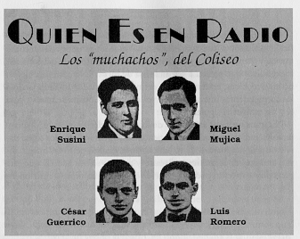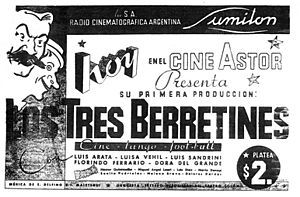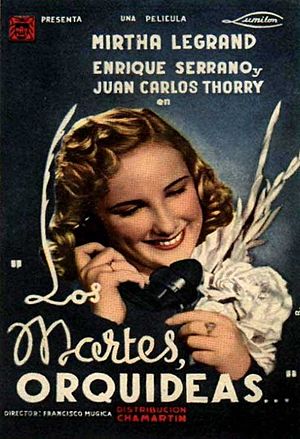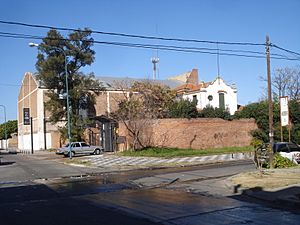Lumiton facts for kids
 |
|
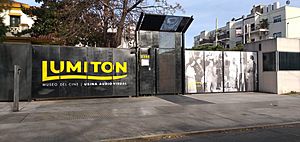
Entrance to the Lumiton Museum in June 2022
|
|
| Private | |
| Industry | Film studio |
| Fate | Bankrupt |
| Founded | 17 December 1932 in Munro, Buenos Aires, Argentina |
| Defunct | 15 May 1952 |
| Headquarters |
,
Argentina
|
|
Area served
|
Latin America |
Lumiton was a film company that made movies. It is now a museum in Munro, Buenos Aires, Argentina. Lumiton Studios started in 1932. This was at the beginning of a special time for movies in Argentina, called the "golden age of film."
Lumiton made movies that were easy to understand and fun for everyone. These films were very popular in Argentina and all over Latin America. In the 1940s, Lumiton was the main rival to another big film company, Argentina Sono Film.
After World War II (1939–1945), Lumiton faced new problems. The government made more rules for film companies. Making movies became more expensive. Also, people started watching more fancy movies from Hollywood. Because of these challenges, Lumiton had to close down in 1952.
Contents
History of Lumiton Films
How Lumiton Started
Lumiton was created in the town of Munro, Buenos Aires. It started with about 300,000 pesos. This was a lot of money back then!
The name "Lumiton" comes from two words: "light" and "sound." Its full name was "Sociedad Anónima Radio Cinematográfica Lumiton." This means "Lumiton Radio Cinematography Company Ltd."
The people who started Lumiton were pioneers. They had already helped start radio broadcasting in Argentina. Now, they were doing the same for movies with sound. They even made one of the first radio broadcasts in the world in 1920. The founders were César José Guerrico, Enrique T. Susini, Luis Romero Carranza, and Miguel Mujica.
The first Lumiton studio was very modern. It had a special lab and great equipment. They even hired a full film crew from the United States. This included the camera director John Alton and sound designer Lazlo Kish.
At that time, the government did not help the film industry with money. Big Hollywood studios could ask for a share of ticket sales. But local studios like Lumiton had to sell their films for a fixed price. So, they had to keep their costs very low.
In its early years, many people were struggling. This was because of the Great Depression in the 1930s. Lumiton's cheap and cheerful movies helped people forget their problems for a while.
There are many different ways of speaking Spanish in Latin America. Sometimes, the Spanish spoken in Spain (called Castilian Spanish) was hard for local people to understand. Also, in the 1930s, many people could not read well. This meant that movies with subtitles would not work.
So, there was a big need for movies made locally with local actors. Lumiton hired actors who were famous from radio or theater. Even though their films were not as fancy as Hollywood movies, people loved them. They enjoyed seeing local actors, stories, and places.
Lumiton became famous for its fun tango films. Carlos Gardel (1890–1935) made tango music popular everywhere. This helped Lumiton sell its movies to many countries in Latin America.
Lumiton's Growth and Success
Lumiton started making films on December 17, 1932. They first made some short test films. Each Lumiton movie began with a special logo. It showed a huge gong being hit by Michael Borowsky, a famous dancer.
Lumiton's first full-length movie was Los tres berretines (The Three Hobbies). It came out in 1933. Enrique T. Susini directed it. It starred popular local actors Luis Sandrini and Luisa Vehil. John Alton, the camera director, might have helped a lot too.
Los tres berretines was released on May 19, 1933. It cost only 18,000 pesos to make. But it earned over one million pesos! The movie was about a family obsessed with three national hobbies: tango, football (soccer), and cinema. Luis Sandrini's acting made him the first big movie star in Argentina.
In 1935, director Manuel Romero joined Lumiton. He made one of Lumiton's biggest hits, a musical called Noches de Buenos Aires (Buenos Aires Nights, 1935). It starred Tita Merello and Fernando Ochoa. He also directed another musical, El caballo del pueblo (The Favorite).
His next film for Lumiton, La muchachada de a bordo (Boys on Board, 1936), was also very popular. Romero made many fun movies for Lumiton. These included the detective film Fuera de la ley (Outside the Law, 1938). He also made the romantic comedy La rubia del camino (The Blonde on the Road, 1938).
Another important film was Mujeres que trabajan (Women Who Work, 1938). This movie was special because it showed women working outside the home. It also featured Niní Marshall in her first movie role. She became a very funny and original comedian. She then starred in many more Lumiton films.
Manuel Romero was Lumiton's main director until 1943. He directed more than half of the studio's movies. He used to write tango songs and direct variety shows. He made happy and simple comedies for working-class people. Romero always showed poor working people with respect. Critics sometimes didn't like his movies because they had simple stories and happy endings. But audiences loved them!
These successful films from Lumiton and other Argentine studios were part of the "golden age" of Argentine cinema. They even made Hollywood try to make Spanish-language films for Latin America. But Hollywood wasn't very successful at it.
La chismosa (The Gossip, 1937), directed by Enrique Susini, was special. It was the first Latin American film to get an award at a European film festival in Venice. Margarita, Armando y su padre (1939) also received an award in Venice.
The Argentine Academy of Cinematography Arts and Sciences started in 1941. The next year, Lumiton won the award for best picture with Los martes, orquídeas, a comedy. The writers and the main actress, Mirtha Legrand, also won awards.
By 1942, Argentina's film industry was the most advanced in South America. Lumiton and other big studios like Argentina Sono Film were at their best.
During World War II (1939–1945), Argentina tried to stay neutral. They didn't want to upset the countries known as the Axis powers. So, they banned or changed some American films. For example, The Invaders (1941) was banned.
Because of this, the United States stopped sending unexposed film to Argentina. This was a big problem for the film industry. Lumiton and Argentina Sono Film were the only studios with enough film to last a year. Other filmmakers had to buy expensive film from the black market in Brazil or Chile.
Lumiton's Final Years
Lumiton and other Argentine studios focused on local stories. These movies were popular with working-class people. But they did not show real social problems.
For twenty years, Lumiton made successful films shown across Latin America. But by the 1950s, local movies started losing viewers. People preferred foreign films that seemed more modern.
Raúl Apold, a government official, made very strict rules for films. The film industry was already struggling. There were fewer viewers, higher costs, and not enough raw materials. Apold's new rules made things even harder.
By the early 1950s, Lumiton was in serious financial trouble. The last film Lumiton finished was Reportaje en el infierno. It was made in 1951–1952 but only released in 1959.
On May 5, 1952, a director named Lucas Demare started filming Un guapo del 900. But just two weeks later, Lumiton ran out of money and had to close down.
In 2004, a museum was built in the old Lumiton studios in Munro. It's now called the Lumiton Museum. It keeps cameras, movie sets, pictures, and posters from the film company.
Films Made by Lumiton
Here are some of the movies Lumiton produced:
- Los tres berretines (The Three Whims, 1933)
- El caballo del pueblo (1935)
- Noches de Buenos Aires (Buenos Aires Nights, 1935)
- La muchachada de a bordo (1936)
- La vuelta de Rocha (1937)
- Fuera de la ley (1937)
- The Boys Didn't Wear Hair Gel Before (1937)
- El cañonero de Giles (1937)
- Jettatore (1938)
- Mujeres que trabajan (1938)
- La chismosa (1938)
- La rubia del camino (1938)
- Tres anclados en París (Three Argentines in Paris, 1938)
- Muchachas que estudian (College Girls, 1939)
- Así es la vida (1939)
- Divorcio en Montevideo (Divorce in Montevideo, 1939)
- Margarita, Armando y su padre (1939)
- La modelo y la estrella (The Model and the Star, 1939)
- La vida es un tango (1939)
- El inglés de los güesos (1940)
- Isabelita (1940)
- Carnaval de antaño (1940)
- Medio millón por una mujer (1940)
- Casamiento en Buenos Aires (Marriage in Buenos Aires, 1940)
- Mi amor eres tú (You Are My Love, 1941)
- Persona honrada se necesita (Honest Person Needed, 1941)
- El tesoro de la isla Maciel (1941)
- Los martes, orquídeas (On Tuesdays, Orchids, 1941)
- Yo quiero ser bataclana (I Want to Be a Chorus Girl, 1941)
- Águila blanca (White Eagle, 1941)
- Un bebé de París (1941)
- El mejor papá del mundo (The Best Father in the World, 1941)
- La novia de primavera (Spring Bride, 1942)
- Historia de crímenes (Tale of Crimes, 1942)
- El viaje (1942)
- Ven mi corazón te llama (When My Heart Calls, 1942)
- Los chicos crecen (The Kids Grow Up, 1942)
- Una luz en la ventana (1942)
- Noche de bodas (1942)
- Adolescencia (1942)
- Safo, historia de una pasión (1943)
- La calle Corrientes (1943)
- El espejo (The Mirror, 1943)
- Dieciséis años (1943)
- El fabricante de estrellas (1943)
- La guerra la gano yo (I Win the War, 1943)
- La hija del ministro (Daughter of the Minister, 1943)
- Mi novia es un fantasma (1944)
- Las seis suegras de Barba Azul (Bluebeard's Six Mothers-in-Law, 1945)
- La señora de Pérez se divorcia (Mrs. Perez and Her Divorce, 1945)
- El canto del cisne (Swan Song, 1945)
- Adán y la serpiente (1946)
- El ángel desnudo (1946)
- La muerte camina en la lluvia (1948)
- Morir en su ley (1949)
- La trampa (1949)
- Yo no elegí mi vida (1949)
- Abuso de confianza (1950)
- ¿Vendrás a media noche? (1950)
- Valentina (1950)
- Filomena Marturano (1950)
- Cartas de amor (1951)
- Las furias (1960)
See also
 In Spanish: Lumiton para niños
In Spanish: Lumiton para niños


